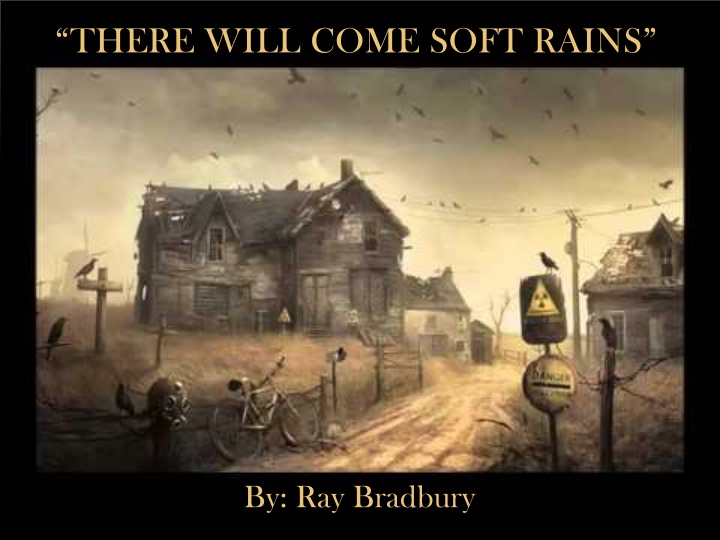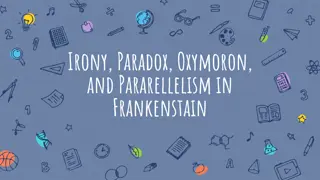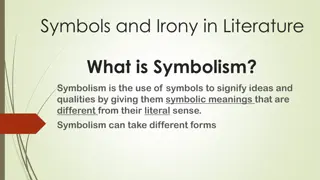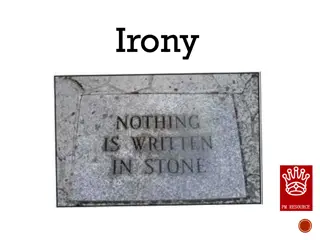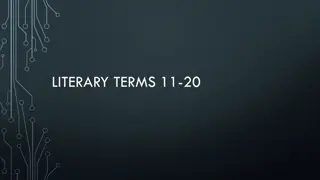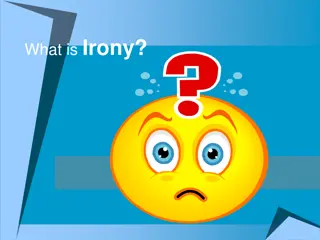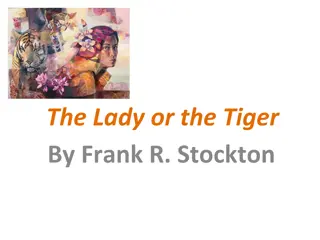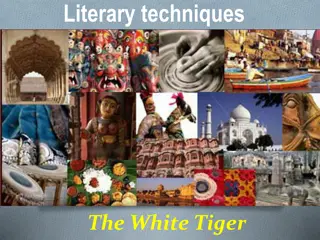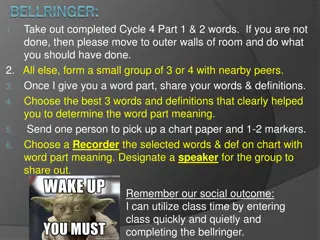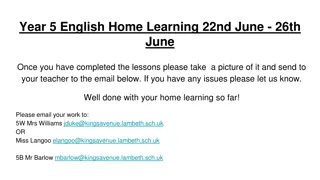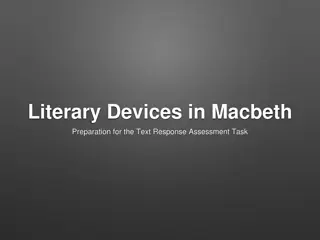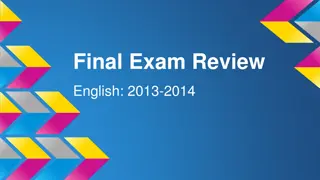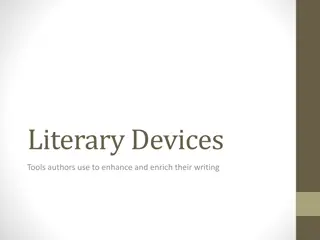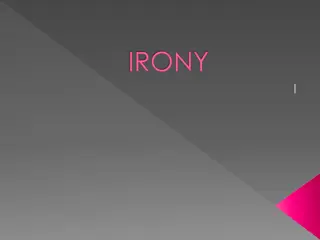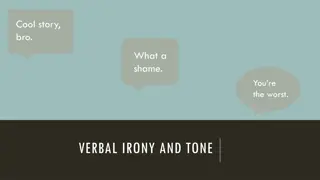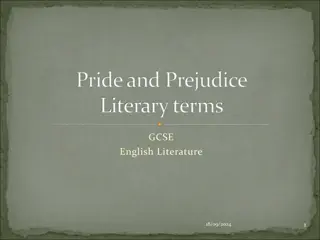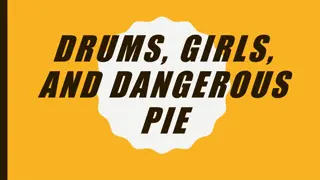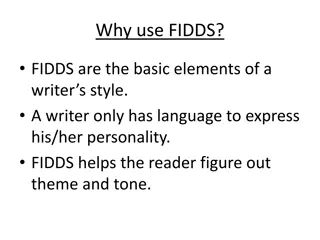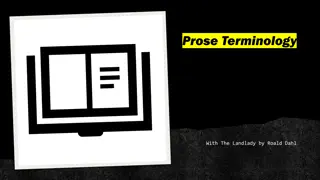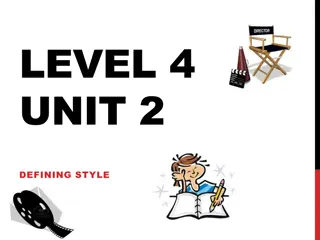Literary Elements Explained: Setting, Protagonist, Antagonist, Irony, Symbolism, Theme
Exploring various literary elements such as setting, protagonist, antagonist, irony, symbolism, and theme using examples from works like "There Will Come Soft Rains" by Ray Bradbury. Dive into the depth of each element and understand their significance in storytelling.
Download Presentation

Please find below an Image/Link to download the presentation.
The content on the website is provided AS IS for your information and personal use only. It may not be sold, licensed, or shared on other websites without obtaining consent from the author.If you encounter any issues during the download, it is possible that the publisher has removed the file from their server.
You are allowed to download the files provided on this website for personal or commercial use, subject to the condition that they are used lawfully. All files are the property of their respective owners.
The content on the website is provided AS IS for your information and personal use only. It may not be sold, licensed, or shared on other websites without obtaining consent from the author.
E N D
Presentation Transcript
THERE WILL COME SOFT RAINS By: Ray Bradbury
SOME TERMS YOU NEED TO REMEMBER: Setting - includes the historical moment in time and geographic location in which a story takes place, and helps initiate the main backdrop and mood for a story. Protagonist - the main character (the central or primary personal figure) of a literary, theatrical, cinematic, or musical narrative, who enters conflict because of the antagonist. Antagonist - a character, group of characters, or institution that represents the opposition against which the protagonist or protagonists must contend. In other words, an antagonist is a person or a group of people who oppose the main character(s).
IRONY Irony is a figure of speech in which words are used in such a way that their intended meaning is different from the actual meaning of the words. It may also be a situation that ends up in quite a different way than what is generally anticipated. In simple words, it is a difference between the appearance and the reality.
IRONY VERSUS COINCIDENCE A coincidence is when two unlikely activities share similarities. You and your friend meet at the mall and you are wearing the same shirt. You and your best friend discover that in your childhood, you had the same breed of dog with the same name. Situational irony is when the end of a situation is VERY different from what you would expect. Your hairdresser has really, really bad hair. Your dentist has terrible teeth. Your French grammar teacher makes mistakes when speaking French. An apple farmer hates apples. In each of the above examples, you would expect a certain situation or characteristic from these people. Instead, you get the opposite. Ironic!
SYMBOLISM Symbolism is the use of an object, person, situation, or word to represent something else. In Edgar Allan Poe s The Raven , the black bird stands for death and loss. In Elie Wiesel s novel Night, night is used throughout the book to represent death, darkness, and loss of faith. In Dr. Seuss s How the Grinch Stole Christmas, the Grinch steals the symbols of Christmas, like trees, presents, and food to find out in the end Christmas was more than those things. In the Harry Potter series by J. K. Rowling, the Golden Snitch represents the spiritual enlightenment every seeker aims for.
THEME Theme - a main idea or an underlying meaning of a literary work that may be stated directly or indirectly. Don t confuse a theme of a literary work with its subject. For example, a writer may choose a subject of war for his story and the theme of a story may be writer s personal opinion that war is a curse for humanity. A writer presents themes in a literary work through several ways. through the feelings of the main character through thoughts and conversations of different characters the experiences of the main character in the course of a literary work the actions and events taking place in a story
THEMES Love and friendship are frequently occurring themes in literature. They generate emotional twists and turns in a narrative and can lead to a variety of endings: happy, sad or bittersweet. Romeo and Juliet by William Shakespeare The theme of war has been explored in literature since ancient times. The literary works utilizing this theme may either glorify or criticize the idea of war. Iliad and Odyssey by Homer A Band of Brothers: Stories from Vietnam by Walter McDonald Crime and mystery are utilized in detective novels. Such narratives also include sub- themes such as crimes cannot be hidden, evil is always punished, etc. Sherlock Holmes by Arthur Conan Doyle Da Vinci Code by Dan Brown
IMAGERY Imagery is the use of figurative language to represent objects, actions, and ideas in such a way that it appeals to our physical senses. Imagery usually makes use of particular words that create a visual representation of ideas in our minds. The word imagery is associated with mental pictures.
IMAGERY It was dark and dim in the forest. The words dark and dim are visual images. The children were screaming and shouting in the fields. - Screaming and shouting appeal to our sense of hearing or auditory sense. He whiffed the aroma of brewed coffee. whiff and aroma evoke our sense of smell or olfactory sense. The girl ran her hands on a soft satin fabric. The idea of soft in this example appeals to our sense of touch or tactile sense. The fresh and juicy orange are very cold and sweet. juicy and sweet when associated with oranges have an effect on our sense of taste or gustatory sense.
IMAGERY Figures of speech, such as similes, metaphors, idioms, and personification are all examples of imagery. An author uses imagery in order to link two ideas and to create a vivid or life-like image in their audience's mind. Remember that, because they are figurative, they are not meant to be taken literally.
SIMILE A simile occurs when an author compares a subject to another that is not usually linked. Often the word 'like' or 'as' combines the two subjects: The school students ran around the playground like a pack of wild animals.. She was as cold as a popsicle. The best way to find a simile in a text is to ask yourself whether or not two unlike things are being compared. You will need to be able to: Recognize a simile State what is being compared Explain the literal meaning of the simile
SIMILE EXAMPLE Tanya waited patiently in line for her ice-cream. The day was very hot and she had run from the house as soon as she heard the familiar tune of the ice-cream van. The soles of her feet were burning but the smooth texture of the vanilla ice-cream was like a cooling breeze, making the wait worthwhile. The simile is ...the vanilla ice-cream was like a cooling breeze. The author has compared the ice-cream to a breeze. These two things are not usually linked. The literal meaning of this simile is that the ice-cream cooled Tanya down.
METAPHOR Metaphors are like similes in that two subjects that are not usually linked are linked. Metaphors are different in that, rather than a simple comparison, a metaphor states that the two subjects are the same or equal. The effect of this is to give one object the attributes of the other. The school students were a wild pack of animals. In this example, the school students are given the attributes of a wild pack of animals. The literal attributes that are being given to the students are that they are noisy and out of control.
IDIOMS Idioms are figurative phrases that are commonly used. Unlike similes and metaphors, there are no rules that define them, other than being figurative. You use idioms all the time without even noticing them. Some include: It's raining cats and dogs. Literally Literally = cats and dogs are falling from the sky. Figuratively Figuratively = It is raining heavily. Under the weather. Literally = Literally = Standing outside. Figuratively = Figuratively = Not feeling well. Head in the sand. Literally = Literally = Having your head buried in the sand. Figuratively = Figuratively = Not noticing what is going on around you.
PERSONIFICATION Personification is a figure of speech where an author has given human qualities to an object or animal. The old tree is an aged and tired man, Its knobbly fingers tremble, reaching out For its withering brown hat, blown off in the wind. The first line is a metaphor. The composer has stated that two objects, a tree and a man, are the same thing. The second two lines give the tree human qualities. The composer has made the trees limbs 'knobbly fingers' and has given the tree a 'brown hat' instead of leaves. These examples of personification help to make the reader empathize with the object.
LETS GET TO WORK! Please read There Will Come Soft Rains by Ray Bradbury. (page 326 - 333) Answer the questions on the worksheet. Read the newspaper article Inside the Home of the Future. (page 337 338) Answer the following prompt: Is technology more harmful or helpful to us? Consider both the advantages and disadvantages of living in a heavily mechanized society. Use information from the short story, the newspaper article, and your personal knowledge.
LETS GET TO WORK! Answer the following prompt: Is technology more harmful or helpful to us? Consider both the advantages and disadvantages of living in a heavily mechanized society. Use information from the short story, the newspaper article, and your personal knowledge. My Claim: State whether technology is more harmful or helpful to us. Evidence from the Short Story: Find evidence (details, facts, or direct statements) from the short story to support your opinion. Evidence from the Article: Find evidence (details, facts, or direct statements) from the article to support your opinion. Evidence: Personal Knowledge: Recall personal knowledge or experiences that support your opinion. Commentary: Connect evidence to answer (without restating exactly what you said in the opening).
